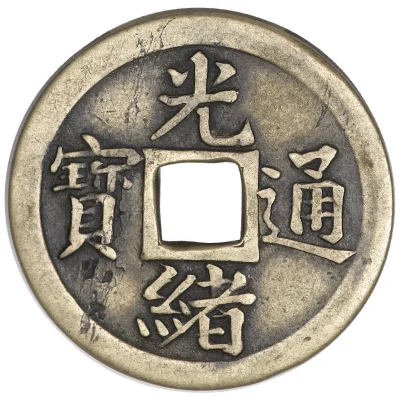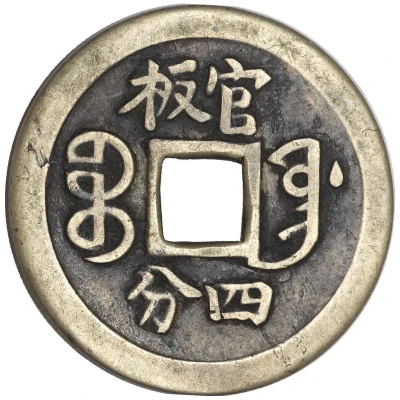1 Cash - Guangxu Tongbao; Boo-dung; with Cun ND
| Brass | - | 20 mm |
| Issuer | Empire of China |
|---|---|
| Emperor | Qing dynasty › Guangxu (光緒帝) (1875-1908) |
| Type | Standard circulation coin |
| Years | 1899-1904 |
| Value | 1 Cash |
| Currency | Cash (621-1912) |
| Composition | Brass |
| Diameter | 20 mm |
| Shape | Round with a square hole |
| Technique | Cast |
| Orientation | Medal alignment ↑↑ |
| Demonetized | Yes |
| Updated | 2024-10-03 |
| Numista | N#226867 |
|---|---|
| Rarity index | 100% |
Reverse
Two Manchu words (read vertically) separated by the hole, all with one Chinese ideogram below.
Scripts: Chinese (traditional, regular script), Mongolian / Manchu
Lettering:
ᠪᠣᠣ ᡩᡠᠩ
村
Translation: Boo-dung / Cun
Edge
Plain
Comment
During Guangxu's reign, two mints used the name 'Boo-dung': Dongchuan, Yunnan and Yantai (Chefoo), Shandong. These 'Cun' pieces are only from the latter.Interesting fact
One interesting fact about the Standard circulation coin 1 Cash - Guangxu (Tongbao; Boo-dung; with Cun) ND (1899-1904) from Empire of China made of Brass is that it was designed by a French engraver named Jean-Antoine Bovy, who was commissioned by the Chinese government to create a new currency for the country. Bovy's design featured a traditional Chinese dragon on one side and the Chinese character for "cash" on the other. The use of brass for the coin was a departure from the traditional copper or silver used in previous Chinese coins, and it was intended to make the coin more durable and resistant to counterfeiting. Despite its durability, the coin was not widely accepted by the Chinese people, and it was eventually replaced by other currency designs.

